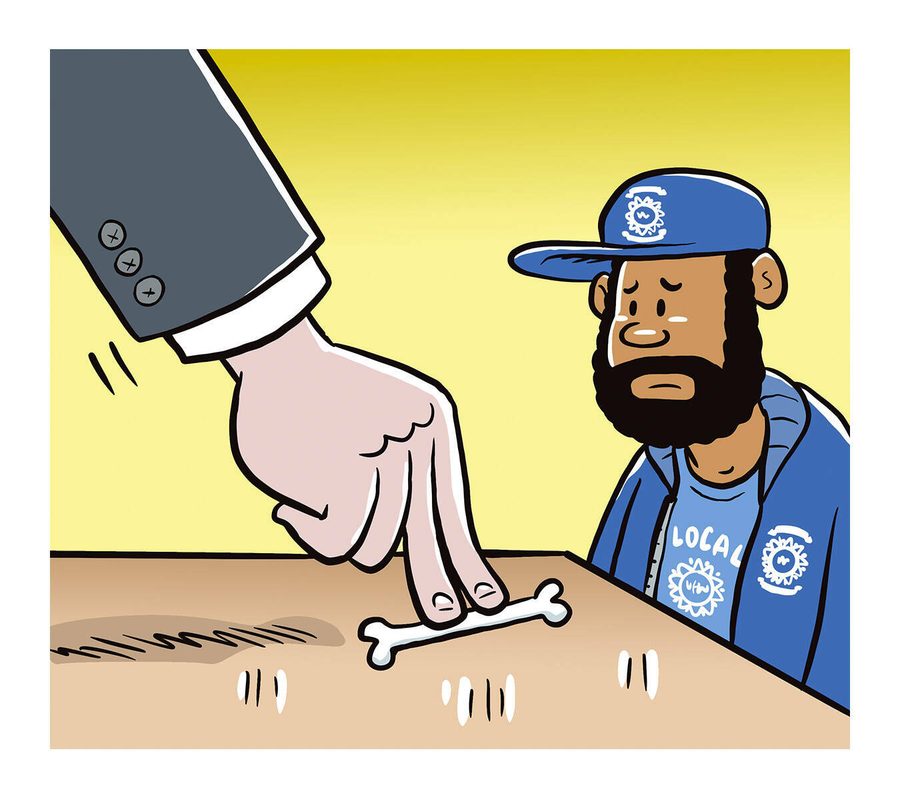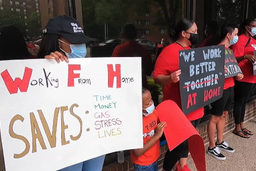Biden Throws Labor a Bone, When We Need Steak
The White House’s Task Force on Worker Organizing and Empowerment suggests stronger laws are needed for fundamental change in labor movement. So where are they?
Hamilton Nolan

President Joe Biden has repeatedly claimed he is overseeing the most pro-union administration in generations, while it increasingly feels like having a very generous friend who is also broke: You appreciate their altruistic spirit, you just don’t actually get much out of it.
The White House Task Force on Worker Organizing and Empowerment, a group with the unenviable job of deciding what the federal government can actually do for organized labor, released a new, underwhelming report in February. And instead of taking the report as another occasion for humdrum press releases, unions should take it as a kick in the ass from the land of political reality.
The context, of course, is that almost all of the really meaningful things the government can do for labor are contained in the PRO Act — as in, Protecting the Right to Organize — a massive labor law reform bill that would be historic in expanding unionization but will not pass Congress so long as the filibuster exists in its current form. Given this fact, the task force report amounts to a search for consolation prizes, like a desperate rummage through the closet for a last-minute birthday party gift.
As a laundry list of pro-labor executive actions and technocratic government agency tweaks, the report is encouraging. As an account of what America’s declining unions can expect from the most pro-union president we may see in decades, it’s rather grim.
The report’s recommendations would make the federal government’s contracting dollars come with more pro-labor strings attached, bolster unionizing among federal government employees, issue union-friendly public information campaigns and try to better enforce existing regulations.
These reforms are good, and enacting all of them would be better than not, but the report carries the intrinsic burden of the White House’s limited reach. Rather than seeing this administration
as one that can revolutionize labor law, it is more accurate for organized labor to think of Biden as the very friendly boss of Federal Government Industries. He can do some good things for workers in his own little kingdom, but for anyone outside the public sector, the brutal class war carries on.
The administration understands this dynamic perfectly well. The task force report says up front, “The Task Force began its work in late April [2021] with a clear understanding that it could not unilaterally reverse the trends [of declining worker power] discussed above,” that “it is important to acknowledge that the Task Force recommendations do not and cannot take the place of the robust legislative change that is needed to fix our labor laws.” That makes the text of the report more frank than the raft of cheery statements some unions issued upon its release, calling it “a significant step forward” and “a historic course correction.”
Just how significant or historic this sort of thing is depends on what you expect. Major unions, battered by corporate America’s wild post-Reagan successes, expect little. They are grateful to be thrown a bone rather than be kicked in the ribs. But if we are going to have a labor movement in America — one that’s worth a damn, that’s larger and stronger than any individual union’s parochial interests — the expectation must be that the half-century-long decline in union power is reversed, that organized labor becomes strong enough to halt the relentless growth of economic inequality.
The higher the expectations, the clearer it becomes that labor must ask for more — while it still has the chance.
What should that ask be?
What is the thing that would be most useful on a large scale, in absence of the PRO Act? Simple: money. Money can hire organizers and produce unions in the same way that money can hire soldiers and produce an army. The labor movement needs a lot of money to spark a lot of organizing. Luckily, the federal government has a lot of money and a purportedly genuine desire to drive unionization. What’s missing? The will of unions to ask for the money to organize the millions of workers who need unions.
As long as unions are satisfied with scraps, they will never ask for the meal.
The task force report rightly states that “the National Labor Relations Act, enacted in 1935, noted that it is the policy of the United States to encourage the practice and procedure of collective bargaining. Unfortunately, the federal government has not always done its part to turn this policy into action.”
Unfortunately, the Biden administration is at risk of failing to do its part as well.
We know the current Congress won’t pass the PRO Act — its Democratic majorities won’t even approve Biden’s signature Build Back Better plan. And the modest steps proposed by this White House report will win only modest gains. With Democrats widely expected to lose control of Congress after the midterms, the time for the labor movement to act is running short.
If this administration really is the most pro-union in generations, then unions should get the federal government to fund union organizing while they still can.
Hamilton Nolan is a labor writer for In These Times. He has spent the past decade writing about labor and politics for Gawker, Splinter, The Guardian, and elsewhere. More of his work is on Substack.









